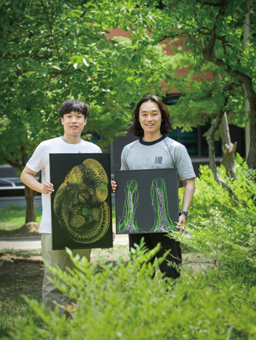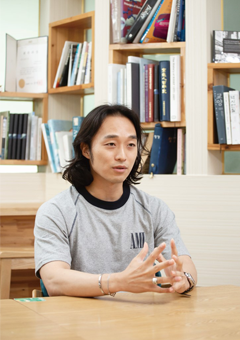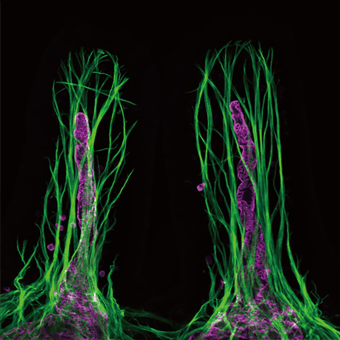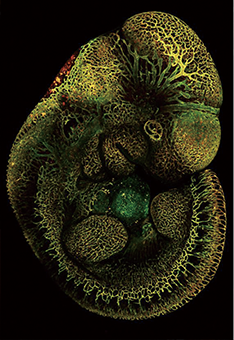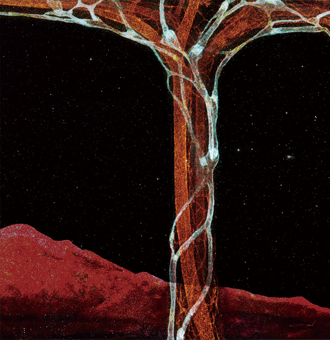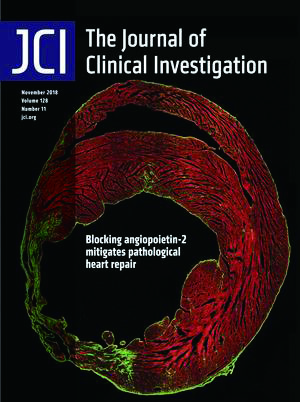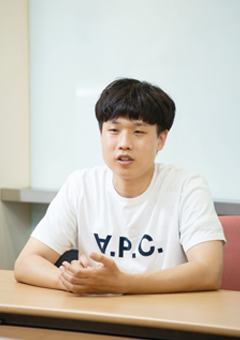주메뉴
- About IBS 연구원소개
-
Research Centers
연구단소개
- Research Outcomes
- Mathematics
- Physics
- Center for Underground Physics
- Center for Theoretical Physics of the Universe(Particle Theory and Cosmology Group)
- Center for Theoretical Physics of the Universe(Cosmology, Gravity and Astroparticle Physics Group)
- Center for Exotic Nuclear Studies
- Dark Matter Axion Group
- Center for Artificial Low Dimensional Electronic Systems
- Center for Theoretical Physics of Complex Systems
- Center for Quantum Nanoscience
- Center for Van der Waals Quantum Solids
- Center for Relativistic Laser Science
- Chemistry
- Life Sciences
- Earth Science
- Interdisciplinary
- Center for Neuroscience Imaging Research(Neuro Technology Group)
- Center for Neuroscience Imaging Research(Cognitive and Computational Neuroscience Group)
- Center for Algorithmic and Robotized Synthesis
- Center for Genome Engineering
- Center for Nanomedicine
- Center for Biomolecular and Cellular Structure
- Center for 2D Quantum Heterostructures
- Center for Quantum Conversion Research
- Institutes
- Korea Virus Research Institute
- News Center 뉴스 센터
- Career 인재초빙
- Living in Korea IBS School-UST
- IBS School 윤리경영


주메뉴
- About IBS
-
Research Centers
- Research Outcomes
- Mathematics
- Physics
- Center for Underground Physics
- Center for Theoretical Physics of the Universe(Particle Theory and Cosmology Group)
- Center for Theoretical Physics of the Universe(Cosmology, Gravity and Astroparticle Physics Group)
- Center for Exotic Nuclear Studies
- Dark Matter Axion Group
- Center for Artificial Low Dimensional Electronic Systems
- Center for Theoretical Physics of Complex Systems
- Center for Quantum Nanoscience
- Center for Van der Waals Quantum Solids
- Center for Relativistic Laser Science
- Chemistry
- Life Sciences
- Earth Science
- Interdisciplinary
- Center for Neuroscience Imaging Research(Neuro Technology Group)
- Center for Neuroscience Imaging Research(Cognitive and Computational Neuroscience Group)
- Center for Algorithmic and Robotized Synthesis
- Center for Genome Engineering
- Center for Nanomedicine
- Center for Biomolecular and Cellular Structure
- Center for 2D Quantum Heterostructures
- Center for Quantum Conversion Research
- Institutes
- Korea Virus Research Institute
- News Center
- Career
- Living in Korea
- IBS School
News Center
| Title | Those Who are Serious About Art In Science | ||||
|---|---|---|---|---|---|
| Name | 전체관리자 | Registration Date | 2022-12-08 | Hits | 3014 |
| att. |
 아트인사이언스.png
아트인사이언스.png
|
||||
Those Who are Serious About Art In ScienceReflecting on the Meaning of Research Beyond Beautiful Images
Sometimes in life, we see sights that are too good to behold alone. It may be a stunning natural landscape, or it may be heartwarming human interactions. When you see a good sight, you will want to leave it as a record and share it with others. This moment also appears during scientific research. How does it feel to share the artistic moments captured during your research with others? We met and heard the stories of the two winners of the ‘Art in Science’ contest held by the Institute for Basic Science. Art in Science was initiated to share with the public the beauty and awe discovered in the process of scientific experiments or research. It started as a small-scale contest in 2015 only for IBS researchers but has grown into a large one open to all researchers. The Center for Vascular Research has participated in the contest since the very beginning, and it has multiple awardees to its name. In 2020, student researcher KANG Seok and research fellow HONG Seon Pyo of the IBS Vascular Research Center won the grand prize and bronze prize, respectively. Dr. Kang won the silver prize in 2021. IBS Research met Dr. Kang and Dr. Hong to find out about their secret to winning. Congratulations on winning the award. How do you feel?
HONG Seon Pyo (HONG) : I am delighted that I won the prize at a time when the quality of the works submitted to Art in Science was very high. It was good to have such an opportunity to share images obtained from research. KANG Seok (KANG) : In 2020, I was surprised and delighted to win a higher prize than I had expected. In the beginning, I simply submitted pretty images that I came across in the course of my experiments. Over time, however, I realized that I wanted to share with others the images from my research. In what research did you get the award-winning images?
HONG The image used for Flowers Covered with Grass, which won the bronze prize in 2020, was obtained when writing a research paper that I published as a post-doctoral researcher. The image was not actually included in the paper, though. Villi are small projections from the wall of the small intestine that play an important role in absorbing nutrients and fats. Inside the villi, there are lymphatic capillaries called lacteals. My research at that time was focused on the essential role that intestinal stromal cells surrounding a lymphatic capillary play in helping the capillary absorb nutrients. In the image, the areas in purple are the capillary and what surrounds it in green are smooth muscle cells.
KANG My research area is the embryonic development of lymphatic capillaries and related key factors. Ancient Future, which won the grand prize in 2020, was the image of mouse embryo blood vessels taken to see the process of vessel development. There are lymphatic valves in the capillaries that make sure the fluid moves in one direction. This is not a tree of 2021 is the image of marker protein of the lymphatic capillaries at the mesentery that connects the intestines and the abdominal wall. It was taken when observing the process of the valves being made. They look like artworks, not just images from actual research. It seems that the combination of colors really mattersHONG The initial images are taken by using different wavelengths, meaning that everything cannot be seen by the human eye. We can only see some wavelengths in the visible light spectrum. I color the image later as I see fit. For Flowers covered with grass, for example, I made the color of the smooth muscle cells green to bring up the image of grass Images for research are unlike artworks. To make objects of the images stand out, contrast colors such as red or green are usually used. Academic journal publishers recommend researchers choose colors more carefully so that those with a color deficiency can clearly see the images
KANG At the Center for Vascular Research, we observe living organisms through highly magnified images. There are many images that make me associate them with something familiar in other fields. I usually choose and refine one of them for the contest, connecting the image to the research that I do. In the case of This is not a tree, I thought that the lymphatic capillaries of the mesentery looked just like a tree. I thought deeply about how to associate a lymphatic capillary with a tree. I worked on the image and came up with the title based on the idea that a lymphatic capillary serves as a medium connecting the inside and outside of the intestines just like a tree connecting the sky and the earth You must put a lot of emphasis on the research implications.HONG Because I am a researcher, I think research intent should manifest itself in the image. An academic paper that presents images with clear research intent is likely to attract others’ interest. I think a good image is one that clearly shows the research outcome. Are there any research images that you consider especially impressive?
KANG At the Center for Vascular Research, we deal with a lot of images and produce many good ones. Many of them were featured on the front covers of different journals. I like the one featured on the cover of the Journal of Clinical Investigation in 2018. The paper was about the high expression of a specific protein in myocardial infarction. The cover image is simple but powerful enough to inspire researchers to study a new treatment based on the observations of the research. Art in Science is growing year by year. As an awardee, is there anything you would like to say to those who will participate in the contest?
HONG Finding pretty images is not difficult. In fact, many of my colleagues at the Center for Vascular Research submit images to the contest. I guess the audience, in the end, will be most moved when they realize what exactly the image is and what the research is about. Every year, great works are exhibited in Art in Science. I can’t wait to see more fantastic works. KANG Researchers can see a world that is far larger or smaller than the actual one that we see in our daily lives. In those worlds, you can find something extraordinary and amazing. I hope it can be shared with many people. |
|||||
| Next | |
|---|---|
| before |
- Content Manager
- Public Relations Team : Yim Ji Yeob 042-878-8173
- Last Update 2023-11-28 14:20










